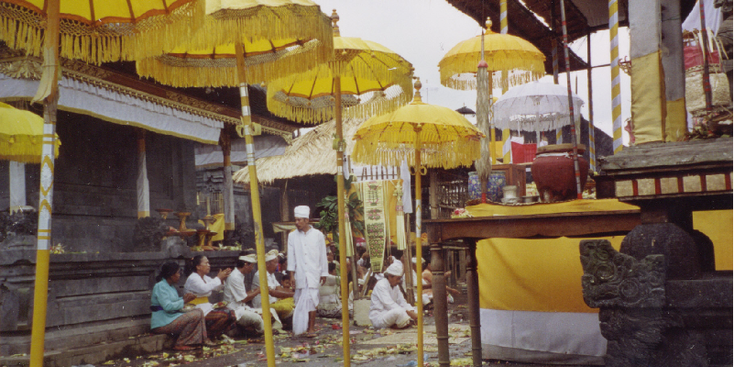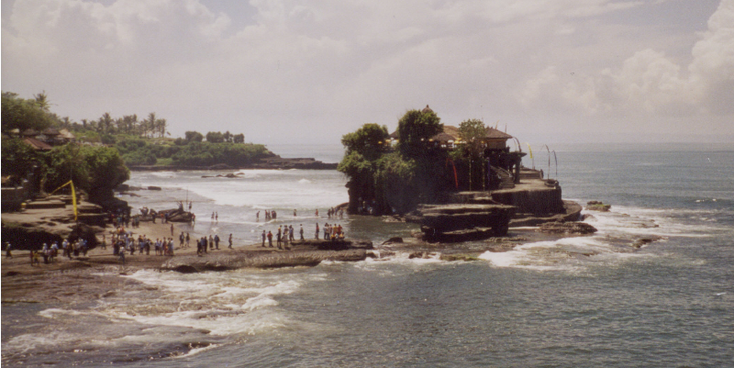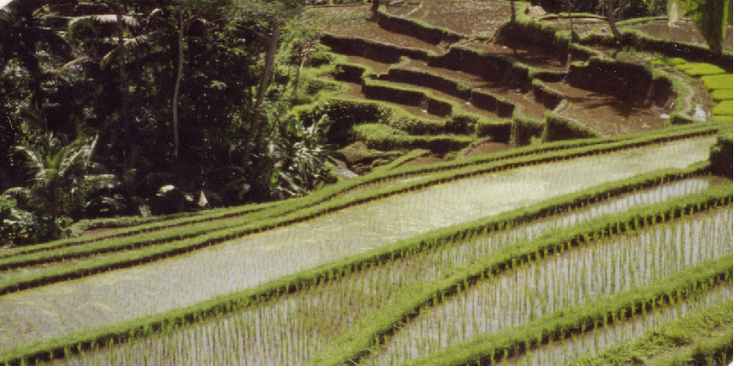Ubud and Kuta (Bali)
Places of Interest - Indonesia


introduction
Bali is the westernmost of the Lesser Sunda Islands and the most popular tourist attraction in Indonesia. The island is dominated by volcanic mountains and some volcanoes are still active. The highest point of the island is the Agung mountain, a volcano with a summit of 3,142 meters above sea level. The Hindu island houses a wealth of natural beauty such as wide sandy beaches with waving palm trees, jungle and nicely landscaped terrace-rice fields.
There are impressive temples, museums, (art)galleries and small villages where locals still make their traditional goods themselves. Culturally and spiritually, Bali is at a high level. Finally, an island has numerous tourist facilities. Main attractions are the very popular and commercial Kuta and the cultural Ubud. Denpasar is the capital of the island.
Nearly 90% of the population belongs to the indigenous population, the Balinese, who are mostly Hindus and speak Balinese or Indonesian.
highlights

Kuta:
The village of Kuta is a former fishing village but was soon discovered by backpackers who turned it quickly into a hippie place in the late 60s. It was one of the first cities in Bali with some tourist industry and quickly grew into a major tourist destination in Indonesia.
It is now internationally known for its long sandy beach with surfing facilities, very varied accommodation, many restaurants and bars and easy access to Bali's international airport. Kuta center is a chaotic labyrinth of small streets and alleys with lots of traffic and people and sometimes a hidden (Hindu) temple.
Neigbourhoods of Seminyak, Legian in the north and Tuban in the south have become more quite but also popular synonyms of Kuta, which are practically merged. You can also visit the impressive monument in honor of the victims of the terrorist attack (where many mostly Australian youths) of 2002.

Ubud:
Beautifully situated among the mountains lies the cultural heart of Bali, the city of Ubud. The main street of Ubud is the Jalan Raya Ubud with many shops (especially art), cafes, restaurants, hotels and the Puri Saren Agung Palace. The latter is a big attraction for tourists with performances by various Balinese dance groups.
The market (pasar) is always busy, interesting and inviting. Ubud itself has numerous attractions that can be reached on foot, but for a number of temples in the area you are advised to rent a bycycle, bemo or motorbike. In the surroundings of Ubud there are beautiful rice fields and numerous museums and galleries that you can view for example through a (organized) bike tour.
The museum is known as Puri Lukisan, consisting of 3 buildings with modern and traditional Balinese art. Also known and pleasant is the Monkey Forest with the famous Monkey Cave, an ancient Hindu temple complex that is now inhabited by a large colony (about 200) macaque monkeys. You can also visit the Pura Dalem Agung Padangtegal, the temple of death. The forest is located next to the village Nyuhkuning, known for its woodworking. If you are lucky you can see a ceremonial (public) funeral in and/or around Ubud.
Goa Gajah (Elephant Cave)
Near Bedulu is the entrance of the cave (Goa Gajah) which dates back to the 11th century and was (re) discovered in 1922. Around the year thousand the cave must already be used by Hindus; probably by Buddhists people before that time.
The Balinese who lived in the area, legend tells us, did not dare to enter the cave. Striking is the mishmash of Hindu and Buddhist elements.
Pura Besakih
The Pura Besakih is the largest temple, situated in the center of Bali, also known as the Mother Temple. The Hindu temple is located on the slopes of the volcano Gunung Agung. It is a sacred temple complex situated on a mountain and accessible by a long staircase.
It’s beenbuilt between the 14th to the 18th century. The temple consists of approximately 200 structures divided over 30 complexes. They are divided over several terraces with several Meru's and pavilions.
Tampaksiring
Tirta Empul is one of the holiest temples in Bali, built around a few hot springs that are now regularly bubbling up in the middle of the garden. Local Balinese pelgrims come here to bathe and to clean themselves spiritually and physically. Barong masks are cleaned here during the galungan. The complex dates back to 960, but the current buildings are all rather modern.

Gunung Kawi
Gunung Kawi is the tomb complex of king Anak Wungsu and his many wives. With a staircase you go 371 steps down where you come to a spot between some beautiful ricefields.
The smaller complex on the south side of the river is of the king's wives, while the larger complex is for the king himself. You must take off your shoes before you go inside.
One kilometer downstream are a number of monasteries.
Tannah Lot
The Balinese temple Tanah Lot lies in the sea on top of a rock. At low tide the temple is just (or just not) accessible over a sanddam (wantij) of about twenty meters long. Access is limited to the first five meters of the mini island. On the accessible part is a 'cave' with a magical source.
Although the temple is in the sea, fresh water comes from this source. Tanah Lot is one of the busiest tourist attractions in Bali, the access road to the temple is therefore turned into a very busy tourist market. At sunset, the many terraces with a view of the temple are filled and a true jungle of photo statues arises.

history

It is without a doubt that Bali has been inhabited since prehistoric times. From the time that Indian traders visited the island and brought Hinduism with it, unfortunately little is known. Bali was under the influence of the much larger and powerful island of Java in different times.
When Islam made its appearance in various parts of present-day Indonesia, the then Hindu kingdom was divided into various independent principalities. In 1597 Dutchmen (the brothers Cornelis and Frederik de Houtman) arrvied at the island for the first time. The skipper wanted to go home but a lot of staff refused to stay in this paradise. From the middle of the 19th century, the island gradually came under Dutch rule. The final, bloody submission took place in 1906, after the Balinese nobility in Badung (men, women and children) massively perpetrated Perang Poeputan (suicide) by just armed with a kris (traditional sword) and a klewang on the enemy fire.
Bali has been part of the Republik Indonesia since the emergence of that republic in 1945. It was not until 1949 that the Dutch left Bali for good after a fierce battle against the Balinese rebels under the leadership of Ngurah Rai. In 1965, the largest anti-communist struggle erupted here before the communist coup. Since then, the island has grown to become the largest tourist attraction in Indonesia. In our century two bomb attacks with many deaths took place on the island ascribed to Jemaah Islamiyah.
The first was on October 12, 2002 in the nightlife district (including at the "Sari Club" and "Paddy's Bar") of the very tourist resort of Kuta; this involved 202 deaths and 209 wounded. On 1 October 2005, attacks were again committed, again in Kuta, but this time also in the equally tourist fishing village of Jimbaran. Three bombs exploded; the number of deaths was 23 this time. Many hotels have been guarded by their own guards since this attack, and cars and guests are also checked. After both attacks there was a big dip in tourist numbers.

tips & advice (2004)

Bali's international airport "Ngurah Rai" is a few kilometers south of Kuta. There are pre-paid taxis leaving the airport. Prices are on the big board just before the exit. Costs to Kuta are about 8 to 10,000R. Capital of Bali, Denpasar, is the transport hub of the Island and has several terminals.
The busses depart from here to different regions of the island. From terminal Ubung to the north of the island, from terminal "Batubulan" to the east and center and from terminal Tegal to the south. In addition, there are some smaller terminals spread over the city. Small vans run between the terminals (bemos).
Bemos are a bit like minibuses. Balinese people make the most use of this, but tourists are also welcome. As a tourist you probably pay double.
Kuta - Denpasar - Ubud: east of Bemo "corner" - on JL Pantai Kuta bemos go to Denpasar terminal Tegal. From there you will first have to go to the terminal Batubulan and then take a bemo to Ubud. You will spend about 2 hours on the entire journey.

-
Name: Hostal (Kuta)
Address: between Poppies Gang I and II
Price: 20,000R (single)
Phone nr. : 754246
Content:
Very popular, very centrally located hostel in the heart ofKuta, not far from the main main passageways from the center to the beach but still quiet. It is neat, clean with a nice garden and a good restaurant. The problem is that the prices have been considerably increased and that it is also often full.
- Name: Anom Bungalows (Ubud)
Address: Jl Arjuna
Price: 15,000R (single)
Content:
In a side street off the busy Monkey Forest Road (Jalan Wanara Wana) is this nice hostel that consists of a number of detached bungalows. Clean, quiet and wonderfully relaxed. Every afternoon a cup of delicious tea awaits you on the porch outside.


RENT BIKE (Ubud):
You can easily rent a regular bike on Bali to make a nice day trip from Ubud for example. Costs are about Rp 20,000 per day. You can also arrange a tour of half a day downhill. You can make a kind of round trip from Ubud direction Sanggingain to Kedewatan and from there to Penestenan, a village known for its painters.
Then you can return to Ubud to make another tour to the beautiful rice fields towards Saki in the north. Between Ubud and Ubud the road to Ubud from the south comes along a number of small villages that are all specialized in a certain form of art, such as Batubulan (stone carving), Celuk (jewelry), Batuan (paintings), and Mas (wood carving). There are large showrooms where everything is offered for sale.
DANCE PRESENTATIONS (Ubud):
As a center for arts, Ubud has every night dance- and wayang performances and baths to heal your chakras. Walk to the information center or to the ARMA to order a ticket and avoid disappointments.
Examples:
-
Puri Saren and Puri Saraswati, Jl. Raya Ubud (just east of Jl Monkey Forest). In the middle of the village, dance performances (Rp 50,000 up) almost every night.
-
The Ubud Palace for a legang and barong dance (Rp 50, 000)
-
Batubulan. Here the national dance, the Barong, is danced. Every day at 9:30. It takes about an hour. Income - Rp50 000.
TOUR Bali:
Because you can not reach everything with a "bemo" and because it is too far with bicycle and too expensive to rent a taxi, you might want to book a combined day trip so you also have a specialized guide who can explain everything. The so-called Besakhi tour takes you on a tour through the northeast of Bali.
-
TIME: 08:45 - 16:00
-
PERSONS: 4x (excluding guide)
CONTENTS trip:
- To Bedulu (goa gajah)
- To Tampaksiring (gunung kawi)
- To Kayuanbua (spice garden)
- To Penelohan (view of volcano and lake of Batur)
- To Besakih
- To Bukit Jambul (view)
- To Klung klung (courtroom)
- To Sidan (view)

see also:
LANDEN:
EUROPA:
Albanië * België * Bosnië-Herzegovina * Bulgarije * Denemarken * Duitsland * Engeland * Estland * Finland * Frankrijk * Griekenland * Hongarije * (Noord) Ierland * Italië * Kosovo * Kroatië * Letland * Litouwen * Luxemburg * Macedonië * Malta * Montenegro * NEDERLAND * Oekraïne * Oostenrijk * Polen * Portugal * Roemenië * Rusland * Schotland * Servië * Slovenië * Slowakije * Spanje * Tsjechië * Turkije * Zweden
NOORD EN CENTRAAL-AMERIKA:
Chili * Costa Rica * Cuba * Guatemala * Mexico * Nicaragua * Panama * Verenigde Staten
ZUID-AMERIKA:
Argentinië * Bolivia * Brazilië * Colombia * Ecuador * Peru
AFRIKA:
Botswana * Burkina Faso * Egypte * Ethiopië * Ghana * Kenia * Mali * Marokko * Namibië * Oeganda * Senegal * Tanzania * Tunesië * Zuid-Afrika
MIDDEN-OOSTEN:
Iran * Israël * Jordanië * V.A.E.
AZIE:
Armenië * Cambodja * China * Filipijnen * Georgië * India * Indonesië * Japan * Kirgizië * Laos * Maleisië * Mongolië * Myanmar * Nepal * Oezbekistan * Singapore * Sri Lanka * Thailand * Vietnam
OCEANIE:
Voor meer reisfoto's kijk op www.instagram.com/cheapskatetravel.nl:
© Cheapskatetravel.nl; 2018 (all rights reserved)


